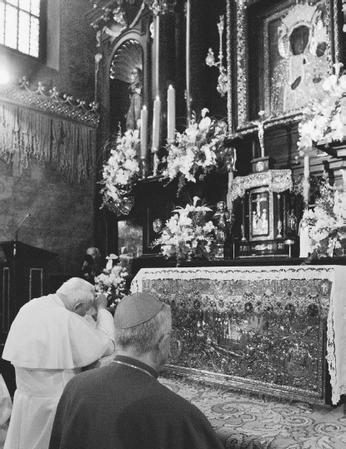Christian Mystery Schools, Cults, Heresies
Black madonna
Of the more than 400 images of the Black Madonna or Black Virgin known worldwide, the image of Our Lady in Czestochowa, Poland, has received the most recent recognition because of the personal devotion displayed toward this religious icon by Pope John Paul II (1920– ). The pope, a native of Poland, prayed before the Madonna of Czestochowa in 1979, several months after his election to the Chair of Peter, and he is known to have made subsequent visits in 1983 and in 1991. The reports of miracles and healings attributed to Our Lady of Czestochowa (also known as Our Lady of Jasna Gora) through the centuries are
numerous. They include Our Lady greatly enhancing the ability of a small group of Polish defenders to protect her sanctuary from an army of Swedish invaders in 1655 and her holy apparition appearing to disperse an invading army of Russians in 1920. Records of such spectacular acts of intervention and dramatic cures are kept in the archives of the Pauline Fathers at Jasna Gora, the monastery site in which the portrait was housed for six centuries.
The Black Madonna of Czestochowa is of such antiquity that its origins are unknown. Tradition has it that St. Luke, the "beloved physician," painted the portrait of Jesus's mother on the cedar wood table at which she took her meals. Two centuries later, during her visit to the Holy Land, St. Helena (c. 248–c. 328), the Queen-Mother of Emperor Constantine (d. 337), is said to have discovered the portrait and brought it to Constantinople in the fourth century. Five centuries later, determined to save the image of the Madonna from the repeated invasions of the Tartars, St. Ladislaus (1040–1095) took the portrait to Opala, Poland, the city of his birth, for safekeeping. Regretfully, not long after its move, a disrespectful Tartar arrow managed to find its way to the Madonna's throat, inflicting a scar that still remains visible. In 1430, Hussite thieves stole the portrait and broke it into three pieces.
Contemporary scholar Leonard Moss has argued against a vast antiquity for the Black Madonna of Czestochowa, claiming that the figure of the woman in the portrait was painted in a distinctly thirteenth- or fourteenth-century Byzantine style. Janusz Pasierb, another scholar who examined the portrait, counters such an assertion, stating that the image was "painted virtually new" in 1434 because of the extensive damage that the portrait had suffered at the hands of vandals.
Another aspect of the mystery of Our Lady of Czestochowa and all the other Black Madonnas that has puzzled many individuals is why they are portrayed with such dark skin tones. Some scholars answer this by stating that it wasn't until the onset of the Renaissance in the fourteenth century that Jesus, Mary, and Joseph began being portrayed with pale skin, blue eyes, and blond or reddish-blond hair. Prior to that period, the Holy Family

Other researchers into the mystique of the Black Madonna state that the reasons that the Roman Catholic Church in general has not warmly embraced such depictions of the Holy Mother or Virgin Mary are because they fear that such representations are actually paying tribute to the ancient goddesses and Earth mothers and that these images perpetuate strains of pagan worship of the female principle. For example, church scholars point out that St. Germain de Pres, the oldest church in Paris (Par-isis, the Grove of Isis), was built in 542 on the site of a former temple dedicated to Isis. Isis had been the patron goddess of Paris until Christianity replaced her with St. Genevieve. Within the church of St. Germain de Pres, however, parishioners worshipped a black statue of Isis until it was destroyed in 1514.
Christianity warred against goddess worship from the days of the apostles when St. Paul (d. 62–68 C.E.) found to his great frustration that his message was being shouted down by the crowds at Ephesus who pledged their obeisance to Diana. Until they had been romanized and westernized, Diana/Artemis, together with the other two preeminent goddesses of the East, Isis and Cybele, were first represented as black madonnas. And before the people of the East bent their knees to Diana, Isis, and Cybele, they had worshipped the Great Mother as Inanna in Sumeria, as Ishtar in Babylonia, and as Astarte among the Hebrews. Most scholars agree that among the first images of the Black Madonna and her son were representations of Isis and Horus.
The Black Madonna may also refer to Mary Magdalene, who, in the traditions of many Christian sects, such as the Gnostics, was the wife of Jesus (c. 6 B.C.E.–c. 30 C.E.) In this interpretation of the events that occurred after Jesus' death at the hands of the Romans, Mary brought the cup used at the Last Supper—the Holy Grail—from Palestine to southern France, where it would eventually be guarded by the Knights Templar.
There is also a belief that Mary arrived in France carrying within her womb a child fathered by Jesus of Nazareth, who then became the progenitor for the royal family of France. For those who hold such beliefs, the Holy Grail is but a metaphor for Mary Magdalene's womb, which carried the true blood of Jesus in the person of his unborn son. Therefore, many of the depictions of the Black Madonna and child throughout the regions of southern France and Spain may be regarded as images of Mary Magdalene carrying the infant son of Jesus rather than the Virgin Mary carrying the infant Jesus.

Comment about this article, ask questions, or add new information about this topic: